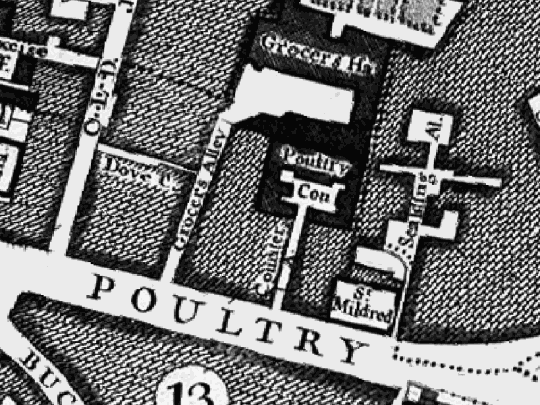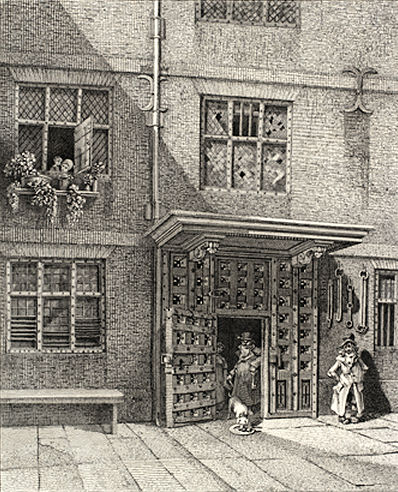Poultry Compter, City of London, London
The Poultry Compter (or Counter) stood on the north side of Poultry, at the east end of Cheapside, in the City of London. In 1603, John Stow wrote:
Some four houseswest from this parish of church St. Mildred is a prison house pertaining to one of the sheriffs of London, and is called the Compter in the Poultrie. This hath been there kept and continued time out of mind , for I have not read of the original thereof.
For much of its history, the Poultry Compter was mainly used to house debtors. The prison's location is shown on the 1746 map below:

Poultry Compter site, City of London, 1746.
Writing in 1803, James Neild outlined the history of the prison up to that date:
It first appears in the reign of Edward the Sixth, when the keeping of it was an office of no small consideration; for, at that period, one John Seymour, at the special recommendation of the King, had a lease granted to him of this Compter, for a term of years. In the year 1600, certain buildings and alterations of this Compter were finished, at an expence of upwards of six hundred pounds; and in the year 1614, the Compter was again partially rebuilt, and repaired with oak. After the Fire of London, in the year 1666, two of the City Gates, Aldgate and Bishopsgate, were converted into Prisons, in lieu of the two Compters, (which were both destroyed in that general conflagration,) until New Compters could be built. For this purpose an order was passed in the year 1669, and executed accordingly. Since then the Wood-street Compter has born pulled down, and a new one erected: But the old Poultry Compter still remains; and was appropriated for the reception of Prisoners, in the manner following.
For Master's-Side Debtors, heretofore, there were fifteen rooms betwixt the inner and outer gates; for the use of which each Prisoner, paid as per Table. For Common-Side Debtors six wards, within the inner gate; two of them on the ground floor, called the King's Ward, and the Prince's Ward; in the former of which, Nov.. 12, 1803, were seven Debtors, and in the latter, the same number.
On the first-floor, or story, was the Women's Ward, with two Debtors; the Middle Ward (so called, as I conceive, from its being betwixt the Women's and Jews' ward) containing six Debtors; and the Jews' Ward, in which were two Jew Debtors, with a separate staircase leading to it. This, let me pointedly observe, is the only Prison I ever visited, in which persons of their persuasion were allowed to have the generous, humane, and just indulgence, of being kept intirely distinct from the other Prisoners: And very sincerely do I hope, that, in the projected change and improvement of this building, some similar allotment will be assigned, of a place of retirement, security, and comfort, for Debtors, or others, of their peculiar description. Reason suggests the motive for such a hint; and Christian principle sanctions its adoption. It may easily be done, as no great space will be requisite.
On the second-story, or floor above, were also the Queen's Ward, which had ten Debtors; and a small room adjoining to it, for the sick.
The 34 Debtors whom I found here at my visits, had ten wives and fifteen children living with them in prison. All are allowed one rug each by the City, but are expected to provide their own beds.
To each ward there is a fire-place. In one of the rooms on the second floor, called the Pump-room, the Debtors had the convenience of water. The court-yard here is very small, paved with flag-stones, and had water continually running through it. In the passage-court was a day-room for Felons, and a small one adjoining to it for Debtors. They have iron-grated windows, opposite the public house, kept within the gates of the Prison; and from which they were constantly supplied with liquor.
Men-Felons slept in two "Strong Rooms," planked with oak, and studded with large broad-headed nails, on boards raised about three feet from the ground; having each a rug allowed them : And up stairs was another large room for Men, and one for Women.
The Chapel, which was below, had a gallery for Master's-Side Debtors; and the Felons, and other Criminals, were seated on forms or benches in the area beneath.
At the top of the whole building are spacious leads, where the Master's-Side Debtors were occasionally allowed to take the air. The Keeper, however, or Turnkey, was always with them; because the adjacent houses were thought capable of furnishing the ready means of escape.
Neild subsequently reported that the prison had descended into a very dilapidated state and many parts needed shoring up with props'. It had became so dangerous that an Act was passed in July 1804 requiring the removal of all the inmates to Giltspur Street Compter until the Poultry building had been made 'secure, and fit, and commodious for the reception of Prisoners'. This was carried out, but overcrowding at Giltspur Street was such that in August 1806 the Poultry was pressed back into service to house the criminal prisoners of both establishments, with the Poultry's chapel being converted to a dormitory.
Writing in 1812, Neild reported that the two rooms fronting the public house had been shut up, and the Queen's Ward, with nearly the whole East end of the Prison, had been demolished. He recorded that:
Master's-Side Felons, or those who can pay for beds, sleep in strong-rooms above stairs ; to which the access is from the Keeper's house.
Common-Side Felons have, within the wooden gate, a small court, paved with flag-stones, and a miserable room, called the Rat Hole, with an iron-grated unglazed window: also two dismal cells to sleep in, upon boards raised about a yard from the floor, with a rug or two each, according to their number; but no straw.
One of these cells is for four Prisoners, and the other for two : Above which are two rooms, of a similar description. The Chapel, since its conversion into a Dormitory, has barrack bedsteads laid on the floor.
The Women-Felons are shut up in a dreary place below, called the Mouse Hole. This will hold sixteen Prisoners, and is fitted up in the same manner as the above are for the Men. Over it is that, which was formerly called the Jews' Ward for Debtors, but now set apart for the sick.
Following the removal of debtors from the Giltspur Street Compter to the new Whitecross Street debtors' prison in 1815, Giltspur Street became a prison and for those sentenced to hard labour for felonies and as a house of correction those committed for assaults and misdemeanors.

Internal view of Poultry Compter, City of London, 1813.
After the inmates of the Poultry Compter were removed to Giltspur Street, the prison closed. A chapel was subsequently built on the site. The Ned Hotel now occupies the location.
Records
Note: many repositories impose a closure period of up to 100 years for records identifying individuals. Before travelling a long distance, always check that the records you want to consult will be available.
- London Metropolitan Archives, 40 Northampton Road, London EC1R OHB.Holdings include: Returns as to state of prison and prisoners' health (1815); Plans (1767-98); Prisoners' lists (1714-1715); Charge books (1782-96, 1800-1815; Commitment books (1792-96, 1800-1815); Inquests into deaths of prisoners (1783-1815).
- The National Archives, Kew, Richmond, Surrey, TW9 4DU. Has a wide variety of crime and prison records going back to the 1770s, including calendars of prisoners, prison registers and criminal registers.
- Find My Past has digitized many of the National Archives' prison records, including prisoner-of-war records, plus a variety of local records including Manchester, York and Plymouth. More information.
- Prison-related records on
Ancestry UK
include Prison Commission Records, 1770-1951
, and local records from London, Swansea, Gloucesterhire and West Yorkshire. More information.
- The Genealogist also has a number of National Archives' prison records. More information.
Bibliography
- Higginbotham, Peter The Prison Cookbook: A History of the English Prison and its Food (2010, The History Press)
- Brodie, A. Behind Bars - The Hidden Architecture of England's Prisons (2000, English Heritage)
- Brodie, A., Croom, J. & Davies, J.O. English Prisons: An Architectural History (2002, English Heritage)
- Harding, C., Hines, B., Ireland, R., Rawlings, P. Imprisonment in England and Wales (1985, Croom Helm)
- McConville, Sean A History of English Prison Administration: Volume I 1750-1877 (1981, Routledge & Kegan Paul)
- Morris, N. and Rothman, D.G. (eds.) The Oxfod History of the Prison (1997, OUP)
- Pugh R.B. Imprisonment in Medieval England (1968, CUP)
Links
- Prison Oracle - resources those involved in present-day UK prisons.
- GOV.UK - UK Government's information on sentencing, probation and support for families.
Except where indicated, this page () © Peter Higginbotham. Contents may not be reproduced without permission.



